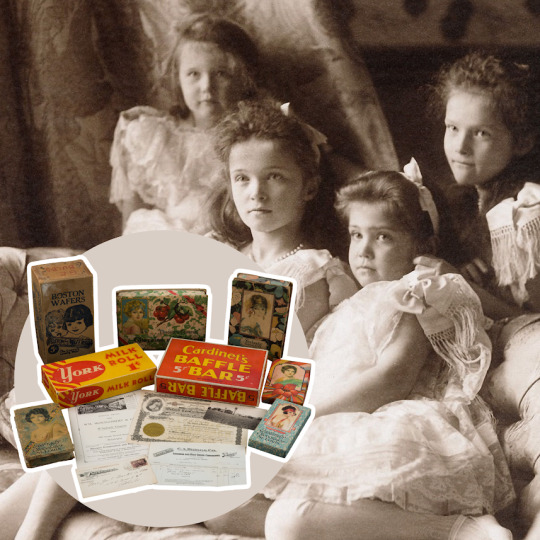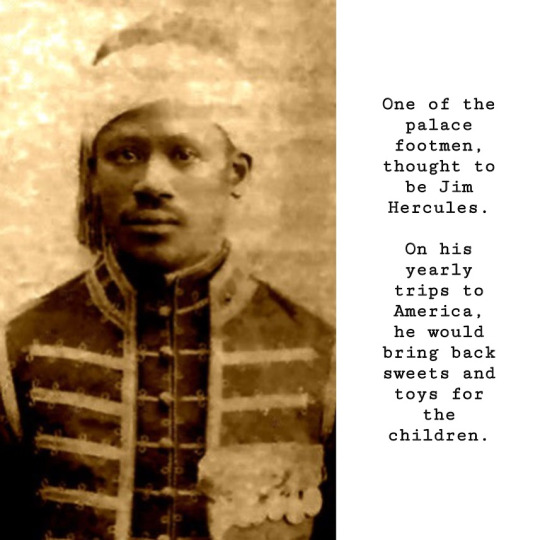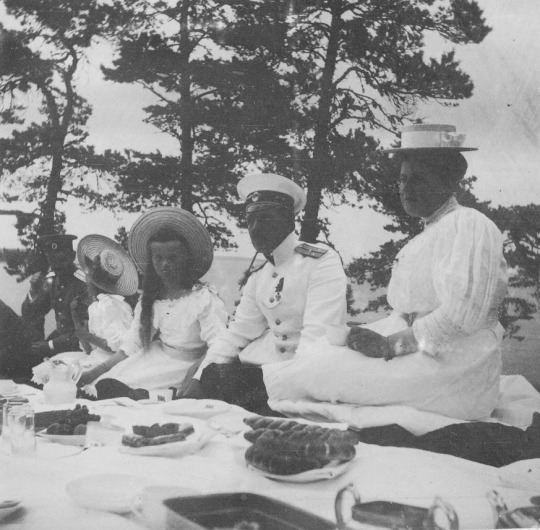#ch: nicholas II of russia
Explore tagged Tumblr posts
Text
The Grand Duchesses and sweets
Scientists working with the dental remains of three of the Grand Duchesses concluded that their dental structure and fillings suggested they were “fond of sweets”.

A favourite of the Grand Duchesses in the palace was Jim Hercules, an African American servant. The Grand Duchesses’ aunt, Olga Alexandrovna, recalls how Jim would spend his “annual holiday in the States and brought back jars of guava jelly as presents for the children.” Jim also brought them other American candy, and toys for their playroom.
The head baker at the palace, Ermolaev, specialised in making pastries and confectionery, and even the yacht Standart was equipped with a confectionery kitchen. However, the children still enjoyed the novelty of foreign imported sweets. In June 1912, it was reported that “when the Grand Duchess Anastasia, daughter of the Emperor Nicholas of Russia, celebrates the eleventh anniversary of her birth on June 18, she will have an abundant supply of American candy. Curtis Guild Jr, American Ambassador to Russia, left New York Tuesday on the Kaiser Wilhelm der Grosse with a trunkful of candy for her.”
In 1916, the Governor of Tver sent the Grand Duchesses pryaniki, a sweet gingerbread cookie biscuit that the region specialised in manufacturing. Sweets were also discussed by fans of the Grand Duchesses: Dolores Sybilla Adam, a teenager from California, once wrote a fan mail letter to Olga Nikolaevna, writing “I should dearly love to make you a great big box of candy and send it to you, from your friend, away in sunny California.”



A love for sweets ran in the family. Conservators recently found a half-chewed piece of sugar paste candy hidden within the dress of the children’s aunt, Grand Duchess Xenia Alexandrovna!

Sources:
Correspondence of the Russian Grand Duchesses: Letters of the Daughters of the Last Tsar, George Hawkins, ([n.p], Independently Published, 2020) [no page numbers], letter beginning Dolores Sybilla Adam to Olga and Tatiana, Nov 25 1913, Amazon Kindle eBook
LUNCH ON THE BALCONY: Recipes from the table of Russia’s last imperial family, Helen Azar, ([n. p.], Independently Published, 2022), Ch. ‘The Confectionary’, [n. p. n] Amazon Kindle eBook
The Many Deaths of Tsar Nicholas II, Wendy Slater, (Oxfordshire: Routledge, 2007), Ch. ‘True Crime’, p. 40, Google Books eBook
Anon. ‘RomanovsOneLastDance’, ‘June 1912’, Tumblr, 25 March 2016
Nicholas and Alexandra, Robert K. Massie, (New York: Laurel, 1985), Ch. ‘The Tsar’s Village’, p. 123, archive.org eBook
Helen Azar, ‘LUNCH ON THE BALCONY: Recipes from the table of Russia’s last imperial family’, (2022), Ch. ‘The Confectionary’
Photos: Public domain, GARF, Heritage Auctions, HA.com, Russia Beyond
#olga nikolaevna#tatiana nikolaevna#maria nikolaevna#anastasia nikolaevna#otma#romanovs#sources#romanov#russian history#sweets#confectionary#cookies#my own
98 notes
·
View notes
Text
Answer to Why didn’t America help Czar Nicholas II flee Russia before he was locked up and executed? by Brent Cooper https://www.quora.com/Why-didn-t-America-help-Czar-Nicholas-II-flee-Russia-before-he-was-locked-up-and-executed/answer/Brent-Cooper-34?ch=18&oid=1477743666283315&share=0732456b&srid=7KVRc&target_type=answer
0 notes
Text
Intro to Film notes, Ch. 17: Soviet montage cinema of the 1920s
Soviet cinema: This refers to films made in the Soviet Union between October 1920 and 1991, although for the purposes of this chapter most Soviet films discussed will be confined to the 1920s.
Ideology: There are two key definitions of this term, one provided by the 19th century German philosopher Karl Marx, the other by the 20th century French Marxist philosopher Louis Althusser. For Marx, ideology was the dominant set of beliefs and values existent within society, which sustained power relations. For Althusser, ideology consisted of the representations and images which reflect society’s view of “reality.” Thus, ideology refers to ‘the myths a society lives by.’
The Soviet montage cinema of the 1920s grew out of the need for a radical new mode of filmmaking to promote the ideology of the Soviet state. How effective these films were as propaganda is debatable, but their influence on filmmaking around the world is undeniable.
Russian cinema: This refers to the body of films made in Tsarist Russia between 1907 and 1917.
The pre-revolutionary Russian films were markedly different from the Soviet films of the 1920s. They were slow-paced and predominantly concerned with the live of the bourgeoisie. It is interesting to note, however, that in the 1910s, Russian artists and poets were already experimenting extensively with ‘montage’ techniques.
Montage: From the French word meaning ‘to edit’, montage means the assembling of pieces of footage to form a whole. In film studies, it usually refers to the style of fast editing adopted by the Soviet filmmakers of the 1920s.
Four Types of Film Montage
Intellectual montage (also called dialectical montage or discontinuity editing)
Linkage editing (also known as constructive editing)
Hollywood montage
fast cutting
Symbolism: The means by which a filmmaker can assign additional meanings to objects/characters in a film. For example, in Dozhenko’s Earth and Eisenstein’s Old and New, the tractor is a symbol of progress.
Key Soviet Montage Filmmakers of the 1920s
A. Fiction
1. Lev Kuleshov
- The Extraordinary Adventures of Mr. West in the Land of the Bolsheviks (1924)
2. Sergei Eisenstein
- Strike (1924)
- Battleship Potemkin (1925)
- October (1927)
- Old and New (1929)
3. Vsevolod Pudovkin
- The Mother (1926)
- The End of St. Petersburg (1927)
- Storm Over Asia (1928)
4. FEKS (Kozintsev & Trauberg)
The Adventures of Oktyabrina (1924)
The Cloak (1926)
The New Babylon (1929)
5. Alexander Dovzhenko
- Arsenal (1929)
- Earth (1930)
B. Documentary
1. Dziga Vertov
- Film Truth (1922)
- Kino-Eye (1924)
- A Sixth of the World (1926)
- The Man With a Movie Camera (1929)
- Enthusiasm (1931)
2. Esfir Shub
- The Fall of the Romanov Dynasty (1927)
- The Great Road (1927)
- The Russia of Nicholas II and Lev Tolstoy (1928)
Soviet montage filmmakers, such as Eisenstein, Pudovkin, Vertov and Kulshov, were both practitioners and theorists who wrote extensively about their techniques. There were, however, significant differences between their approaches to editing. Pudovkin, for example, rejected Eisenstein’s belief that shots should be in ‘collision.’
Some Soviet filmmakers, such as Vertov, believed that fiction film could not be used to reveal the truth about a society and therefore based his films on documenting events around him.
The montage cinema of the 1920s came to an abrupt halt in the 1930s, when the Soviet authorities (under the leadership of Stalin) demanded that filmmakers create more popular films with hero-led narratives and realistic subject matter. Arguably, however, the demise of montage cinema was also linked to the advent of sound in the 1930s, which generally required longer takes to facilitate the recording of dialogue.
Other filmmakers, such as Shub, were tasked by the Soviet government to create new meanings by re-editing Russian newsreels and foreign films to conform to the new Soviet ideology.
Propaganda cinema: A term used pejoratively with reference to any film that consciously attempts to persuade an audience towards certain beliefs and values.
Juxtaposition: In film studies, this usually refers to two different shots that have been joined together to make a contrast.
The French theorist Bazin claimed that the audience of montage cinema was essentially passive as the director forced the audience towards certain meanings. Instead, Bazin advocated a cinema that captured a record of events before the camera with minimum mediation.
Hollywood cinema: In classical Hollywood cinema, the editing is designed to be ‘invisible.’ It is intended to allow the audience closer views and to see the POV of different characters. The editing is used essentially to clarify what is taking place in the narrative. This type of editing had become dominant in Hollywood filmmaking by approximately 1920.
Dominant: Refers to both economic strength and the dominant form or convention, which at this time is realism. Dominant cinema in film studies is assumed to be Hollywood.
Cinema attendance records suggest that the Soviet montage films were not popular with audiences and that imported American films (such as Robin Hood) were more successful at the Soviet box office.
Alternative: The Soviet cinema of the 1920s could certainly be regarded as ‘alternative’ as it offered a style of filmmaking that was radically different to the mass of films being produced in America.
Dialectical: A difficult term to define, as it has many different meanings. The Collins English Dictionary (2nd edition, 1986), for example, defines it as a ‘disputation or debate, esp. intended to resolve differences between two views rather than to establish one of them as true.’ The crucial factor to grasp in the context of Eisenstein’s thinking, however, is the notion of change and the creation of a new order. Eisenstein would have defined dialectic with reference to Marxist philosophy, which believed that society was contradictory and in need of change.
0 notes
Text
For Anastasia
read it on the AO3 at https://ift.tt/2GPQCbT
by CarolinaCreed
What could possible go wrong in a romance between a princess and a diplomat? This is the story of how James Walpole fell in love with the Grand Duchess Anastasia in one of his missions.
Words: 1361, Chapters: 1/?, Language: English
Fandoms: Anastasia (1997), Anastasia - Flaherty/Ahrens/McNally
Rating: Mature
Warnings: Graphic Depictions Of Violence, Underage
Categories: F/M
Characters: Original Male Character(s), Anastasia Nikolaevna Romanov Grand Duchess of Russia, Tatiana Nikolaevna Romanova Grand Duchess of Russia, Maria Romanov, Olga Romanov, Nikolay Alexandrovich Romanov | Nicholas II of Russia, Alix of Hesse | Alexandra Feodorovna
Relationships: Anastasia Nikolaevna Romanov Grand Duchess of Russia/Original Male Character(s)
read it on the AO3 at https://ift.tt/2GPQCbT
#fanfic#anastasia#anastasia 1997#IFTTT#ao3feed#ch: anya | anastasia romanova#ch: tatiana romanova#ch: maria romanova#ch: olga romanova#ch: nicholas ii of russia#ch: alexandra feodorovna
1 note
·
View note
Text
https://snapshotsofhistory.quora.com/Queen-Victoria-with-her-son-Albert-Edward-Prince-of-Wales-right-and-Tsar-Nicholas-II-of-Russia-left-Seated-on-the
https://snapshotsofhistory.quora.com/Queen-Victoria-with-her-son-Albert-Edward-Prince-of-Wales-right-and-Tsar-Nicholas-II-of-Russia-left-Seated-on-the https://snapshotsofhistory.quora.com/Queen-Victoria-with-her-son-Albert-Edward-Prince-of-Wales-right-and-Tsar-Nicholas-II-of-Russia-left-Seated-on-the?ch=15&oid=50838253&share=5bc8f6fe&srid=7KVRc&target_type=post
0 notes
Text
Once Upon A Winter's Night
read it on the AO3 at http://ift.tt/2zbvxoo
by softfawnbabe
An alternate history where the Bolshevik revolution failed. Mainly just for my own fun, not gonna lie. Though I have based this off of historical facts somewhat, this is not mean to be accurate completely. This is primarily a drama/romance story, NOT a representation of what probably would've happened if the revolution really did fail.
Words: 396, Chapters: 1/1, Language: English
Fandoms: Anastasia (1997), Anastasia - Flaherty/Ahrens/McNally, The Romanov Family
Rating: Teen And Up Audiences
Warnings: Creator Chose Not To Use Archive Warnings
Categories: F/M
Characters: Dimitri | Dmitry (Anastasia), Anastasia Nikolaevna Romanov Grand Duchess of Russia, Gleb Vaganov, Alexei Nikolevich Romanov, Ileana of Romania, Maria Nikolaevna Romanov, Nikolay Alexandrovich Romanov | Nicholas II of Russia, Nicholas of Romania, Alix of Hesse | Alexandra Feodorovna, Pooka (Anastasia 1997), Grigori Yefimovich Rasputin
Relationships: Dimitri | Dmitry/Anastasia Nikolaevna Romanova, Anastasia Nikolaevna Romanov Grand Duchess of Russia/Gleb Vaganov, Alexei Nikolevich Romanov/Ileana Of Romania, Gleb Vaganov/Maria Nikolaevna Romanov
Additional Tags: Emotional/Psychological Abuse, Implied Childhood Sexual Abuse, Revenge, Imperial Officers (Star Wars), 1910s, Alternate History, Alternate Universe, Eventual Smut, Eventual Happy Ending, Historical Inaccuracy, True Love, Mysticism, Forbidden Love, Love Triangles, Temporarily Unrequited Love, Unrequited Lust, Non-Graphic Violence, Hemophilia, Chronic Illness, Character Death, Family Drama, Family Feels
read it on the AO3 at
http://ift.tt/2zbvxoo
#fanfic#anastasia#anastasia 1997#IFTTT#ao3feed#ch: anya | anastasia romanova#ch: dmitry | dimitri#sh: anya/dmitry#ch: gleb vaganov#ch: alexei romanov#ch: Ileana of Romania#ch: maria romanova#ch: nicholas II of russia#ch: nicholas of romania#ch: alexandra feodorovna#ch: pooka#ch: rasputin#sh: anya/gleb#sh: alexei/ileana#sh: gleb/maria
2 notes
·
View notes
Link
Chapters: 3/? Fandom: Anastasia - Flaherty/Ahrens/McNally Rating: Teen And Up Audiences Warnings: Creator Chose Not To Use Archive Warnings, No Archive Warnings Apply Relationships: Anastasia Nikolaevna Romanov Grand Duchess of Russia/Gleb Vaganov Characters: Anastasia Nikolaevna Romanov Grand Duchess of Russia, Gleb Vaganov, Dimitri | Dmitry (Anastasia), Nikolay Alexandrovich Romanov | Nicholas II of Russia, Romanov Sisters, Alexei Romanov, Vaganov Family, Several Russian OCs Additional Tags: Alternate Universe - Arranged Marriage, the au you didn't need but you're getting anyways, Alternate History, don't take this too seriously and suspend your disbelief Summary:
The Tsar and his family live, and make it out of Yekaterinburg. But the Bolsheviks live too, and the tsar's power is greatly reduced. Tensions between the White Russians and Red Russians are simmering, and before they get to a boiling point, key leaders of both sides decide that something must be done to unite the two factions. A kicker is proposed at the end of several long policy and government changes: a Romanov daughter is set to marry a good and loyal son of the Bolshevik faction.
That son is twenty-two year old Gleb Vaganov, a Party member who would really just like to read his copy of Pravda in peace, and that daughter is nineteen year old Anastasia Romanova, who wasn't planning on being married until all three older sisters walked down the aisle and still helps her brother Alexei with his pranks.
In other words, it's as close to a romcom as you can get in 1920s Communist Russia.
#queue#anastasia#anastasia musical#anastasia broadway#fanfic#ch: anya | anastasia romanova#ch: gleb vaganov#sh: anya/gleb#ch: nicholas II of russia#ch: olga romanova#ch: tatiana romanova#ch: maria romanova#ch: alexei romanov
0 notes